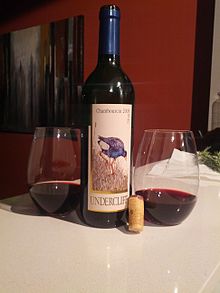Chambourcin
| Chambourcin | |
|---|---|
| Grape (Vitis) | |
 Chambourcin grape before the color change of veraison. | |
| Color of berry skin | Red |
| Species | Hybrid grape |
| Origin | France, created by Joannes Seyve |
| VIVC number | 2436 |
Chambourcin (French pronunciation: [ʃɑ̃buʁsɛ̃]) is a variety of grapevine belonging to the Vitis genus in the flowering plant family Vitaceae. It is a French-American interspecific hybrid grape variety used for making wine. Its parentage is uncertain, but genetic studies show it likely includes several North American Vitis species in its background including: V. berlandieri Planch., V. labrusca L., V. lincecumii Buckley, V. riparia Michx., V. rupestris Scheele, and V. vinifera.[1] The hybrid was produced by Joannes Seyve who often used Seibel hybrids produced in the 1860s. The grape has only been available since 1963; it has a good resistance to fungal disease, and is one of the parents of the new disease resistant variety, Regent, which is increasing in popularity among German grape growers.
Chambourcin is considered a very productive grape with crop yields reported ranging from 11.1 tons per hectare to 17.3 tons per hectare in a study performed by Ohio State University.[2]
Chambourcin wine

The grape produces a deep-colored and aromatic wine. It can be made into a dry style or one with a moderate residual sugar level. Chambourcin is a teinturier, a grape whose juice is pink or red rather than clear like most red vitis vinifera cultivars.
The red juice fermented over the red skins can produce a very strongly flavoured wine. Most red wines are served at cellar temperature of 55 to 58 °F (13 to 14 °C) to bring out the flavour but some Chambourcin wines have such a strong flavour that it is recommended that they be served chilled.[3]
Wine regions
Chambourcin has been planted widely in the mid-Atlantic region of North America, particularly in such states as New Jersey, New York, and Pennsylvania. It is also grown in Harrow and Ruthven, Ontario, and in Kelowna, B.C., Canada; several counties in Virginia; Frederick, Washington, Harford, Prince George's County, Maryland, Calvert County, Maryland, and St. Mary's County, Maryland; Kent County, Delaware; Monroe County, Indiana; Daviess County, Kentucky; in the Ohio River Valley AVA Ohio; in the Lake Erie AVA of Ohio, New York, and Pennsylvania; Greenbrier, Calhoun, Roane, and Mineral counties in West Virginia; Allegan County, Michigan; the Shawnee Hills AVA of southern Illinois; the Yadkin Valley and Haw River Valley of North Carolina; Western Tennessee in the Mississippi Delta AVA[4][circular reference]; [[Missouri[Augusta AVA] Missouri]]; south-central Kansas; Norman Oklahoma; New Zealand's Northland Region;[5] the Hunter Valley Region of New South Wales and other warm, humid regions in Australia; also in France and Portugal.
References
- ^ Patel, Sagar; Harris, Zachary N.; Londo, Jason P.; Miller, Allison; Fennell, Anne (2023-07-03). "Genome assembly of the hybrid grapevine Vitis 'Chambourcin'". Gigabyte. 2023: 1–18. doi:10.46471/gigabyte.84. ISSN 2709-4715. PMC 10318349. PMID 37408731.
- ^ Dami, Imed (2005). "Influence of Crop Level on 'Chambourcin' Yield, Fruit Quality, and Winter Hardiness" (PDF). The Ohio State University. hdl:1811/56335. Retrieved July 6, 2014.
- ^ BBQ Red Wine - http://www.sailfishcove.co.nz/product/bbq-red/
- ^ Mississippi Delta AVA
- ^ "Chambourcin – Sailfish Cove Vineyard". 28 January 2021.
